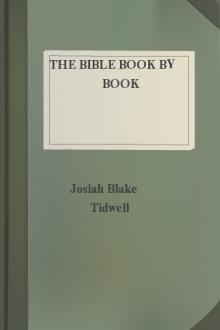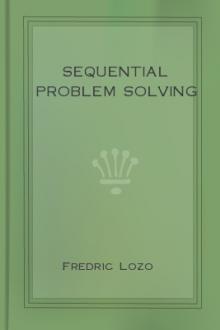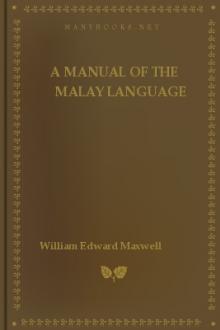The Bible Book by Book by Josiah Blake Tidwell (best short books to read .txt) 📕

- Author: Josiah Blake Tidwell
- Performer: -
Book online «The Bible Book by Book by Josiah Blake Tidwell (best short books to read .txt) 📕». Author Josiah Blake Tidwell
The Times and Circumstances of the Writings. These are so different from those which influenced the other evangelists that one can hardly escape the feeling that John's gospel is colored accordingly. The gospel had been preached in all the Roman empire and Christianity was no longer considered a Jewish sect, attached to the Synagogue. Jerusalem had been overthrown and the temple destroyed. Christians had been sorely persecuted, but had achieved great triumphs in many lands. All the rest of the New Testament except Revelation had been written. Some had arisen, who disputed the deity of Jesus and while the gospel is not a mere polemic against that false teaching, it does, by establishing the true teaching thoroughly undermine the false. He perhaps wrote to Christians of all nationalities, whose history had by this time been enriched by the blood of martyrs for the faith. Instead of the Messiah in whom Jews would find a Savior or the mighty worker in whom the Roman would find him, or the Ideal Man in whom the Greeks would find him. John wrote concerning the eternal, Incarnate Word in whose Spiritual Kingdom each, having lost his narrowness and racial prejudice, could be forever united.
The Style and the Plan.
This gospel differs from the others in language and plan. It is both profound and simple and has several elements of style as follows: (1) Simplicity. The sentences are short and connected by coordinate conjunctions. There are but few direct quotations, and but few dependent sentences, and most of them show the sequence of things, either as a cause or a purpose. (2) Sameness. This arises from the method of treating each step in the narrative as if isolated and separate from all the rest rather than merging it into the complete whole. (3) Repetition, whether in the narrative proper or in the quoted words of the Lord, is very frequent. The following examples will illustrate this: "In the beginning was the word and the word was with God and the word was God." "The light shineth in darkness and the darkness comprehendeth it not." "I am the Good Shepherd; the Good Shepherd giveth his life." "Jesus then, when he saw her weeping and the Jews that were weeping with her." "If I bear witness of myself my witness is not true. There is another that beareth witness of me; and I know that the witness which he witnesseth of me is true." Let the student gather a list of all such repetitions. (4) Parallelism, or statements expressing the same or similar truths, such as the following are common. "Peace I leave with you, my peace I give unto you"; "Let not your heart be troubled, neither let it be afraid"; "I give unto them eternal life and they shall never perish." This parallelism, which at the same time becomes repetition, is seen in the way a subject or conclusion is stated and, after elaboration, restated in a new and enlarged view, thus teaching the truth in a gradually unfolding beauty and force. An illustration is found in the statement, "I will raise him up in the last day," 6, 39, 70, 44. (5) Contrasts. The plan is more simple and more easily seen all along than is that of any other of the Evangelists. On the one hand, he shows how love and faith are developed in the believer until, in the end, Thomas, who was the most doubtful of all, could exclaim, "My Lord and my God." On the other hand, he shows the unbeliever advanced from mere indifference to a positive hatred that culminated in the crucifixion. This purpose is carried out by a process of contrasting and separating things that are opposites, such as (a) Light and darkness, (b) Truth and falsehood, (c) Good and evil, (d) Life and death, (e) God and Satan. In all of these he is convincing his reader that Jesus is the Christ, the son of God.
Characteristics and Purpose.
1. It Is a Gospel of the Feasts. Indeed, if subtract from it those miracles and teachings and other works performed in connection with the feasts, we should have only a few fragments left. The value of the book would be destroyed and the most beautiful and the profoundest teachings of the gospel lost.
The student will do well from the following list of feasts to endeavor to group around each all that John records as occurring in connection with it. (1) The Feast of the Passover (2:13, 23), First Passover, A. D. 27. (2) A Feast of the Jews (5:1), probably Purim. (3) Passover a Feast of the Jews (6:4), Second Passover, A. D. 28. (4) Feast of the Tabernacles (7:2). (5) Feast of the Dedication (10:22). (6) Passover (11:55-56; 12:1, 12, 20; 13:29; 18:28). Third Passover, A. D. 29.
2. It Is a Gospel of Testimony. John writes to prove that Jesus is the Christ. He assumes the attitude of a lawyer before a jury and introduces testimony until he fells certain of his case and then closes the testimony with the assurance that much more could be offered if it seemed necessary. There are seven lines of testimony. (1) The testimony of John the Baptist. (2) The testimony of certain other individuals. (3) The testimony of Jesus' works. (4) The testimony of Jesus himself (see the I am's). (5) The testimony of the scripture. (6) The testimony of the Father. (7) The testimony of the Holy Spirit.
3. It Is of Gospel of Belief. The purpose being to produce belief there are given: numerous examples of belief, showing the growth of faith; the secret of faith, such as hearing or receiving the word; the results of faith, such as eternal life, freedom, peace, power, etc.
4. It Is a Spiritual Gospel. It represents the deeper mediations of John, which are shaped so as to establish a great doctrine which, instead of history, became his great impulse. To John "history is doctrine" and he reviews it in the light of its spiritual interpretation. It furnished a great bulwark against the Gnostic teachers, who had come to deny the diety of Jesus. He also emphasized and elaborated the humanity of Jesus. His whole purpose is "not so much the historic record of the facts as the development of their inmost meaning."
5. It Is a Gospel of Symbolism. John was a mystic and delighted in mystic symbols. The whole book speaks in the language of symbols. The mystic numbers three and seven prevail throughout the book not only in the things and sayings recorded but in the arrangement of topics. Each of the Eight Miracles is used for a "sign" or symbol, as the feeding of the five thousand in which Jesus appears as the bread or support of life. The great allegories of the Good-Shepherd, the sheep-fold and the vine; the names used to designate Jesus as the Word, Light, the Way, the Truth, the Life, etc., all show how the whole gospel is penetrated with a spirit of symbolic representation.
6. It Is the Gospel of the Incarnation. "Matthew explains his messianic function; Mark his active works and Luke his character as Savior." John magnifies his person and everywhere makes us see "the word made flesh." God is at no great distance form us. He has become flesh. The word has come as the Incarnate Man. Jesus, this Incarnate Man, is God and as such fills the whole book, but he, nevertheless, hungers and thirsts and knows human experience. God has come down to man to enable him to rise up to God.
Subject: Jesus, the Christ, God's Son.
Analysis.
Introduction or prologue, 1:1-18.
(1) The divine nature of the word. 1-5.
(2) The manifestation of the word as the world's Savior, 6-18.
I. The Testimony of His Great Public Ministry, 1:19-12 end.
1. He is revealed, 1:19-2:12.
2. He is recognized, 2:13-3 end.
3. He is antagonized, Chs. 5-11.
4. He is honored, Ch. 12.
II. The Testimony of His Private Ministry with His Disciples, Chs. 13-17.
1. He teaches and comforts his disciples, Chs. 13-16.
2. He prays for his disciples, Ch. 17.
III. The Testimony of His Passion. Chs. 18-19.
1. His betrayal, 18:1-11.
2. The Jewish or ecclesiastical trial, 18:12-27.
3. The Roman or civil trial, 18:28-19:16.
4. His death and burial, 19:17 end.
IV. The Testimony of His Resurrection and Manifestation, Chs. 20-21.
1. His resurrection and manifestation to his disciples, Ch. 20.
2. Further manifestations and instructions to his disciples, Ch. 21.
For Study and Discussion.
(1) The events and discourses connected with each feast mentioned above. (2) The seven lines of testimony mentioned above. List examples of each. (3) The following miracles as "signs," pointing out what they symbolize about Jesus: (a) The Cana miracle, 2:1-11; (b) The nobleman's son, 4:48-54; (c) The impotent man, 5:1-16; (d) Feeding five thousand, 6:3-14; (e) Walking on the sea, 6:16-20; (f) Healing the blind man, 9:1-16; read all the chapter; (g) Raising Lazarus, Ch. 11; (h) The draft of fishes, 21:1-11. (4) The following discourses: (a) The conversation with Nicodemus, Ch. 3; (b) The conversation with the woman at the well, Ch. 4; (c) The discourse on the shepherd and the sheep, Ch. 10; (d) The discussions of chapter 13; (e) The discourse on the vine, Ch. 15; (f) The Lord's prayer, Ch. 17. (5) From the following passages find the cause or explanation of unbelief, 1:45; 3:11, 19, 20; 5:16, 40, 42, 44; 6:42, 52; 7:41, 42, 48; 8:13, 14, 45; 12:26, 44; 20:9. (6) From the following study the results of unbelief, 3:18, 20, 36; 4:13, 14; 6:35, 53, 58; 8:19, 34, 55; 14:1, 28; 15:5; 16:6, 9. (7) Make a list of all the night scenes of the book and study them. (8) Study each instance of someone worshiping Jesus. (9) Name each chapter of the book so as to indicate some important event in it-as the vine chapter or Good Shepherd chapter. (10) Find where and how many times each of the following words and phrases occurs and study them as time will admit. (1) Eternal life, 17 times, only 18 in all the other gospels, (2) believe, (3) believe on, (4) sent, (5) life, (6) sign or signs (Revised version), (7) work or works, (8) John the Baptist, (9) verily, always double and used by Jesus, (10) receive, received, etc., (11) witness, or testify, testimony, etc.. (12) truth, (13) manifest, manifested, (14) "I am" (spoken by Jesus).
Acts.
Chs.1-9.
The Author. The author is Luke who wrote the gospel of Luke. Facts concerning him may be found in chapter twenty-seven. He wrote this book about A. D. 63 or 64.
The Purpose. It was addressed to an individual as a sort of continuation of the former thesis and aims to chronicle the growth and development of the movement inaugurated by Jesus as it was carried on by the apostles after the resurrection and ascension of Jesus. It is taken up largely with the history of Christian work among the Gentiles and only gives enough of the history of the Jerusalem church to authenticate the work among the Gentiles. The chief purpose, therefore, seems to be to give an account of the spread of Christianity among the Gentiles. This view is further strengthened in the fact that Luke himself was a gentile (Col. 4:10) and that he was a companion of Paul (Col. 4:14) and the "we" section of Acts. The book does not, therefore, claim to be a complete account of the labors of the early apostles. But it does give in a simple, definite and impressive manner an account of how the religion of Jesus was propagated after his death and of how it was received by those to whom it was first preached.
The Spirituality. In the Old Testament God the Father was the active agent. In the gospels God the Son (Jesus) was the active agent. In Acts (and ever after) God the Holy Spirit is the active agent. He is mentioned about seventy times in Acts. The Savior had told the apostles to wait at Jerusalem for the





Comments (0)